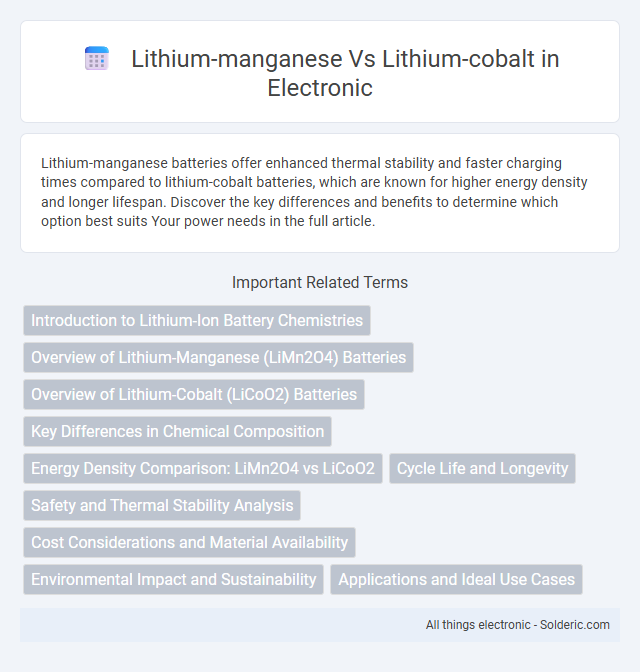Lithium-manganese batteries offer enhanced thermal stability and faster charging times compared to lithium-cobalt batteries, which are known for higher energy density and longer lifespan. Discover the key differences and benefits to determine which option best suits Your power needs in the full article.
Comparison Table
| Feature | Lithium-Manganese (LiMn2O4) | Lithium-Cobalt (LiCoO2) |
|---|---|---|
| Energy Density | Lower (~100-120 Wh/kg) | Higher (~150-200 Wh/kg) |
| Cycle Life | Good (800-1000+ cycles) | Moderate (400-700 cycles) |
| Thermal Stability | High (safer, less risk of overheating) | Lower (more prone to thermal runaway) |
| Cost | Lower (manganese is abundant and cheaper) | Higher (cobalt is expensive and less abundant) |
| Voltage | 3.7 V nominal | 3.6-3.7 V nominal |
| Applications | Power tools, electric vehicles, medical devices | Smartphones, laptops, high energy-demand devices |
Introduction to Lithium-Ion Battery Chemistries
Lithium-manganese (LiMn2O4) and lithium-cobalt (LiCoO2) are two popular lithium-ion battery chemistries, each offering distinct advantages in energy density and safety. Lithium-cobalt batteries provide higher energy density, making them ideal for smartphones and laptops, while lithium-manganese batteries excel in thermal stability and power output, suitable for power tools and electric vehicles. Choosing the right chemistry depends on your device's specific requirements for performance, lifespan, and safety.
Overview of Lithium-Manganese (LiMn2O4) Batteries
Lithium-Manganese Oxide (LiMn2O4) batteries feature a spinel structure that provides enhanced thermal stability and safety compared to Lithium-Cobalt Oxide (LiCoO2) batteries. Their high power output and longer cycle life make them suitable for applications requiring rapid discharge and recharge, such as power tools and electric vehicles. Your energy storage solutions can benefit from LiMn2O4's lower cost and environmentally friendlier composition, despite its slightly lower energy density than LiCoO2 counterparts.
Overview of Lithium-Cobalt (LiCoO2) Batteries
Lithium-cobalt oxide (LiCoO2) batteries feature a layered structure that enables high energy density, making them ideal for use in smartphones, laptops, and other portable electronics. These batteries offer excellent voltage stability and long cycle life, though their reliance on cobalt raises concerns about cost and ethical sourcing. Compared to lithium-manganese batteries, LiCoO2 cells generally provide higher capacity but lower thermal stability and safety margins.
Key Differences in Chemical Composition
Lithium-manganese batteries utilize lithium manganese oxide (LiMn2O4) as the cathode material, offering a stable spinel structure that enhances thermal stability and safety. Lithium-cobalt batteries use lithium cobalt oxide (LiCoO2) as the cathode, which provides higher energy density but lower thermal stability compared to lithium-manganese. The chemical differences impact battery performance, with lithium-manganese favoring safety and longevity, while lithium-cobalt emphasizes higher capacity and energy output.
Energy Density Comparison: LiMn2O4 vs LiCoO2
Lithium-cobalt oxide (LiCoO2) typically offers higher energy density, around 150-200 Wh/kg, compared to lithium-manganese oxide (LiMn2O4), which usually ranges between 90-130 Wh/kg. The higher energy density of LiCoO2 makes it suitable for applications demanding long battery life and compact size, such as smartphones and laptops. Your choice depends on whether energy density or thermal stability and lifespan is the priority, as LiMn2O4 provides better safety and cycle life despite its lower energy capacity.
Cycle Life and Longevity
Lithium-manganese batteries offer superior cycle life and longevity, typically providing around 1,000 to 2,000 charge cycles due to their stable spinel structure, which reduces capacity degradation. Lithium-cobalt batteries, while delivering higher energy density, usually endure only about 300 to 500 cycles before significant capacity loss occurs, limiting their lifespan in long-term applications. Choosing lithium-manganese cells can enhance Your device's durability and reduce replacement frequency, making them ideal for extended use scenarios.
Safety and Thermal Stability Analysis
Lithium-manganese batteries exhibit superior safety and thermal stability compared to lithium-cobalt counterparts due to their stable spinel structure, which reduces the risk of thermal runaway and overheating during high discharge rates. The manganese-based cathode maintains structural integrity under stress, minimizing oxygen release that commonly triggers fires in lithium-cobalt cells. Thermal management tests reveal that lithium-manganese cells sustain lower temperature increases during thermal abuse conditions, making them a safer choice for high-power applications.
Cost Considerations and Material Availability
Lithium-manganese batteries generally offer a more cost-effective solution compared to lithium-cobalt, primarily due to the lower cost and higher abundance of manganese. Cobalt's limited availability and ethical sourcing challenges contribute to higher prices and supply chain risks, impacting the overall expense of lithium-cobalt batteries. When evaluating battery options, your decision should weigh both the cost savings and the material availability linked to these distinct cathode chemistries.
Environmental Impact and Sustainability
Lithium-manganese batteries exhibit a lower environmental impact compared to lithium-cobalt batteries due to the abundance and less toxic nature of manganese, reducing mining-related ecological damage and health risks. Lithium-cobalt batteries rely heavily on cobalt, which is often mined under environmentally harmful and ethically contentious conditions, leading to significant sustainability challenges. Transitioning to lithium-manganese technology supports improved recyclability and a smaller carbon footprint, enhancing overall battery sustainability.
Applications and Ideal Use Cases
Lithium-manganese batteries offer high thermal stability and are well-suited for power tools, electric bicycles, and medical devices where safety and high discharge rates are critical. Lithium-cobalt batteries provide greater energy density, making them ideal for smartphones, laptops, and other portable electronics requiring long-lasting, compact power sources. The choice between these chemistries depends on prioritizing either safety and power output or energy density and device size.
Lithium-manganese vs Lithium-cobalt Infographic

 solderic.com
solderic.com